A new TVA policy to cut -- not trim -- all trees from its 16,000 miles of transmission tower rights-of-way in the Tennessee Valley has run into a buzzsaw.
The utility says a federal energy regulatory group has a new guideline that states a utility can have zero outages because of vegetation. To ensure reliability, TVA has decided to cut any tree that is or can ever grow taller than 15 feet in its 100-foot, 150-foot and 200-foot rights-of-way, according to TVA spokesman Travis Brickey.
"It's a matter of safety and reliability," he said.
Homeowners near the power towers see it differently, and many of them are madder than hornets.
"It's not just the beauty of the trees. They shade my house," said Jim Millburn, standing in the middle of Valley Trail off Mountain Creek Road with several of his neighbors.
TVA's new cut policy will take virtually every tree in every front yard, even though the utility already boasts of a 99.999 percent reliability rate in the pamphlets distributed in the neighborhood last month.
"They're gutting our street," said Hugh Pinkleton, a TVA retiree. "I've lived here more than 25 years. They used to give you an option to have your tree trimmed back at your expense or they would cut it."
Neighbor Emily Duffey fears the trees will be "mowed down."
"We own our house, but we have no options," she said. They're just bullying everybody on the street."
Cutting is just beginning in Chattanooga neighborhoods, but it's in full swing in Knoxville and already has raised such a ruckus that a federal lawsuit has been filed by two families there.
Some of the neighbors along Chattanooga's Valley Trail say they already have talked to one of the Knoxville attorneys in hopes that it might be a class-action suit. So far that's not an option, they said.
Pinkleton is trying another tack: On April 7, he emailed Sen. Lamar Alexander, R-Tenn.; Sen. Bob Corker, R-Tenn.; and Rep. Chuck Fleishmann, R.-Tenn.
TVA's changed policy "will definitely affect the value and beauty of my property," he said. "I respectively request your help in evaluating TVA's current policy concerning tree cutting in residential areas and stopping any cutting until this issue has been resolved."
Pinkleton said he has had no replies.
He and his neighbors began hearing about the total cut plan in late March when TVA representatives began knocking on doors and telling them what to expect.
Brickey said if the TVA representative found no one home, a packet was left on the door.
TVA so far has declined to talk about the lawsuit, saying instead that the federal utility's attorneys will respond in court.
But Brickey said the rights-of-way on file are explicit, giving TVA the right to cut the trees.
He said TVA hasn't always exercised the right to clear all vegetation from any given right of way, sometimes leaving "borders" of plant material.
Now the utility will use all of the rights-of-way.
The new policy of fully exercising that right is valleywide, he said, and will affect all seven states where TVA owns transmission power towers.
Jason Regg, TVA's applied lines service manager of the eastern region of Tennessee Valley, including North Georgia and the eastern half of Tennessee, North Carolina and Alabama, calls it "reclamation of the full easement."
"Don't get the impression TVA just decided to do maintenance," he said. "We've been doing this forever, but its more aggressive now than in the past."
Regg and Brickey said the new guideline that prompted TVA's new policy arose out of an August 2003 blackout in the Northeast U.S. and Canada that affected 50 million people. Officials determined the blackout was caused by tree contact with transmission lines.
On the heels of the blackout and federal legislation, the Federal Energy Regulatory Commission designated the North American Electric Reliability Corp. as the Electric Reliability Organization. That group was tasked with the responsibility to develop and enforce standards to ensure the reliability of the Bulk Power System -- the interconnected electric grid of major power suppliers. The reliability standards include right-of-way vegetation management and tree trimming, according to the Federal Energy Regulatory Commission's website.
But the website is clear: The standard "requires" that trees in or adjacent to the power line right-of-way "be trimmed to prevent power outages" caused by tree contact with a transmission line. It also states: "Each utility develops and implements its own tree trimming or vegetation management plan."
Regg said TVA decided the maximum approach will save money over time.
"On a 500 kilovolt line, if we have an outage, or if they find a tree too close [to transmission lines], TVA can be fined up to $1 million a day," said Regg.
"Any time TVA saves money, ratepayers save money," Brickey said.
All the new guideline talk is lost on Barbara Reichman, who has lived in the same Valley Trail house for 30 years.
In her yard stands a magnolia she and her husband planted just after they moved in. The yard also holds two 50-year-old cherry trees.
TVA has never viewed those trees as threats before, said the small elderly Reichman, clasping a heavy sweater around herself in the bright Wednesday sun.
"I guess if TVA comes we could all be treehuggers, she said.
Her friend, Carole Mullins, smiled and shook her head.
"We don't know how to fight TVA," she said.
